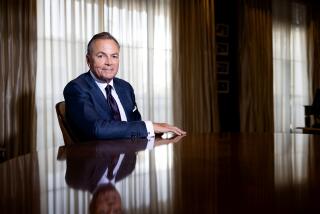Rick Caruso to develop $550-million open-air attraction on Las Vegas Strip
- Share via
One of the world’s biggest casino operators has hired Los Angeles shopping center magnate Rick Caruso to develop a $550-million retail and entertainment district in the middle of the Las Vegas Strip crowned by an enormous Ferris wheel.
Caruso, who is weighing a run for mayor of Los Angeles, was tapped by Caesars Entertainment Corp. to oversee creation of the Linq, a new open-air attraction across Las Vegas Boulevard from Caesars Palace.
The outdoor venue would have more in common with Caruso’s Grove shopping center in Los Angeles than it would with hermetically sealed casinos. City leaders hope the Linq with its bars, restaurants and stores will become a destination with special appeal to the gambling mecca’s growing Gen X and Gen Y clientele.
“There are millions of people walking around the sidewalk in Vegas,” Caruso said, “but they have nowhere to go except inside.”
The Linq represents a new tack for luring visitors to Las Vegas, which has mostly relied on ever grander resorts to generate buzz in years past. A building boom and the recession left casino companies overloaded with hotel rooms and debt, pressing the city to find other ways to entice tourists.
This time, the new attraction will be the world’s tallest observation wheel called the Las Vegas High Roller. At 550 feet, it is to stand 100 feet taller than the London Eye. Groups of up to 40 could fit into each of the 28 transparent cabins for the half-hour round trip.
Construction on the Linq is set to begin late this year and to be completed by 2013. The project has been approved by Clark County, Nev., officials and has financing, according to Caesars. The project would be a quarter-mile long and hold more than 200,000 square feet of shops, eateries and bars. Caruso said he would select retailers who did not already have outposts in Las Vegas, but he declined to name potential tenants.
Caruso, who also developed the Americana at Brand in Glendale, said the Linq would have a Vegas sensibility without being gaudy.
“We are not looking to reinvent ourselves,” he said. “We are bringing what we do well.”
Like the Grove and Americana, the Linq will have elaborate fountains and host events such as outdoor concerts. The design will include shading and heating elements to address temperature spikes in the desert.
Caruso also hopes to manage the Linq for Caesars after it opens, an arrangement that’s still under discussion. It would be the first project that his company Caruso Affiliated would operate but not own.
It could be years before Las Vegas celebrates another major resort opening; the economy is soft and all the major casino companies are laden with debt from the building boom. But tourism boosters must still find ways to entice recession-weary visitors to the Strip. More modest projects such as the Linq give them a way to market something new.
Caesars has been planning the Linq since 2007, said Greg Miller, senior vice president of development.
“The conclusion we reached back even before downturn was that we didn’t need more hotel capacity,” and the search was on for something that Vegas didn’t have, Miller said. “We looked at the Grove and said that’s it.”
For two decades Las Vegas went on a building spree, imploding run-down casinos and opening multibillion-dollar mega-resorts. In doing so, the Strip mostly sidestepped a quandary other tourist destinations faced: how to win over new visitors while bringing old ones back.
Tourists who had giggled at the Excalibur castle returned to gawk at the Luxor pyramid. When themed casinos gave way to upscale resorts such as the Bellagio, Venetian and Wynn Las Vegas, they tried to top one another in terms of opulence. The annual number of visitors soared from 16 million to 39 million in two decades. That’s why tourism boosters crowed that in Las Vegas, supply created demand.
The recession quashed that theory. A string of casinos has opened since 2007, when the recession began, but none of them has revived tourism like officials hoped. When the largest project, MGM Resorts International’s CityCenter, opened in December 2009, Chief Executive Jim Murren predicted that it would woo at least 5% more tourists to the beleaguered Strip. Instead, visitation inched up 2.7%.
For years, resorts have slashed hotel rates — a key source of revenue — to fill tens of thousands of rooms. Although visitation, room rates and gaming revenue have picked up through the first half of 2011, national economic jitters threaten to wipe out what was widely viewed as a budding recovery.
Meanwhile, other hotel-casino projects on Las Vegas Boulevard stalled. The Fontainebleau and Echelon, abandoned midway through construction, have languished for years, while the Sahara recently went dark with no immediate plans to reopen. CityCenter’s Harmon condo-hotel tower was lopped in half because of construction defects and the flagging economy. MGM Resorts officials this week asked the county for permission to implode it.
The Linq will replace a road that runs between the Flamingo and the Imperial Palace, Miller said. It is the first major project in Las Vegas to be announced since the recession humbled the city.
“It was good idea before the downturn,” he said. “Now it’s really a good idea. This symbolizes our confidence that the market is and will continue to be the most important entertainment destination in the country.”
.
More to Read
Inside the business of entertainment
The Wide Shot brings you news, analysis and insights on everything from streaming wars to production — and what it all means for the future.
You may occasionally receive promotional content from the Los Angeles Times.











